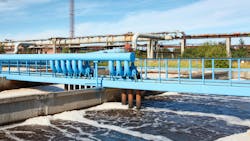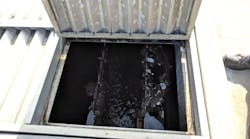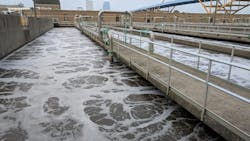What is Aeration?
Aeration is the process by which air is circulated through, mixed with or dissolved in a liquid or substance.
Aeration brings water and air in close contact in order to remove dissolved gases and to oxidize dissolved metals, including iron, hydrogen sulfide, and volatile organic chemicals (VOCs). This process is typically the first major process at drinking water treatment plant, and occurs in the secondary treatment processes of activated sludge treatment in wastewater treatment plants. An evenly distributed oxygen supply in an aeration system is essential to effective wastewater treatment for fostering microbial growth.
According to the Missouri Rural Water Association, the efficiency of aeration depends on the amount of surface contact between air and water. This is primarily controlled by the size of the water drop or air bubble. Aeration brings water and air in close contact by exposing drops or thin sheets of water to the air or by introducing small bubbles of air and letting them rise through the water. Dissolved gases are then removed from the solution and allowed to escape into the surrounding air.
Aeration in Wastewater Treatment
In municipal and industrial wastewater treatment, aeration is part of the secondary treatment process. The activated sludge process is the most common option in secondary treatment, according to Oxymem.
Aeration is an activated sludge process, promoting microbial growth in the wastewater. The microbes then feed on organic material, forming flocks which easily settle out. Once settled in a separate settling tank, bacteria forming the "activated sludge" flocks are continually recirculated back to the aeration basin, increasing decomposition rates.
In industrial use, the most common method of aeration is water-fall aeration, through the use of spray nozzles. There is also the air diffusion method of aeration, in which air is diffused into a receiving vessel containing counter-current flowing water.
Aeration is used in liquids, soils and foods to improve quality and reduce contamination. The process is used to oxidize soluble iron and manganese to insoluble precipitates. Aeration can also reduce ammonia and hydrogen sulfide and is ideal for bacteria control.
When it comes to industrial water conditioning, the major objective of aeration is to remove carbon dioxide, according to Corrosionpedia.
Types of Aeration
There are several different types equipmented that can be used for wastewater aeration, including fine bubble diffusers, coarse bubble diffusers and surface aeration systems.
Fine Bubble Diffusers
Fine bubble diffusers are energy efficient submersible aeration systems for wastewater treatment. Fine Bubble diffuser systems disperse the diffused gas volume to transfer an equal amount of oxygen as a coarse bubble system, according to Environmental Dynamics International.
The fine bubble technology is a form of subsurface aeration that introduces air into water via very fine bubbles. Thousands of the fine bubbles promote the transfer of oxygen to water, maximizing air-water contact in the process.
Coarse Bubble Diffusers
Coarse bubble diffusers produce a larger diameter of bubble to displace, churn and mix the wastewater effectively.
Fine pores typically release bubbles with a diameter between 0-3 millimeters, while coarse bubble diffusers release bubbles with a diameter ranging from 3-50 millimeters.
Coarse bubble aeration is best-suited for conventional aeration, highly loaded systems, sludge storage, aerobic digesters and channels.
Surface Aeration
Surface aeration is best in shallow water applications or when large amounts of oxygen are needed immediately. According to Kasco Marine, splashing style surface aerators create more surface area for the gas exchange, which can add large amounts of oxygen to the water.



